Rings and small satellites
Neptune’s ring arcs
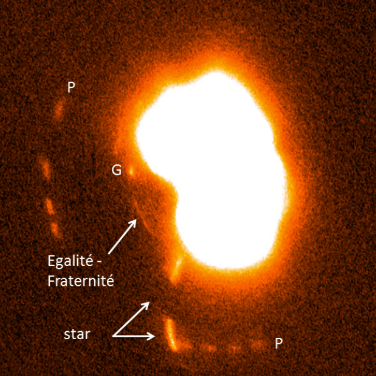
Around Neptune, four arcs are confined in a 40 degrees azimuthal range. These incomplete rings have been stable since their discovery in 1984 (Hubbard et al. 1986), while they should be destroyed in a few months through differential Keplerian motion. Nevertheless, images obtained since 2002 with the Keck, VLT, HST telescopes (de Pater et al. 2005, Renner et al. 2014, Showalter et al. 2013, 2017) show some significant changes in the brightness and longitudes of the arcs.
A satellite on an eccentric/inclined orbit creates corotation resonance sites where arcs can be azimuthally confined (Goldreich et al. 1986). Such a resonance has been identified (Porco 1991), the 42:43 corotation inclination resonance forced by the nearby satellite Galatea. However, the arcs finally revealed to lie close to but not within this resonance (Dumas et al. 1999, Sicardy et al. 1999). Therefore the mass of the arcs must be taken into account in the corotation model to explain the stability of these structures (Namouni and Porco 2002). Alternatively, relative equilibrium positions between few co-orbital bodies generalizing the Lagrange L4/L5 configurations can be considered (Renner and Sicardy 2004, Renner et al. 2014).
Saturn’s small satellites
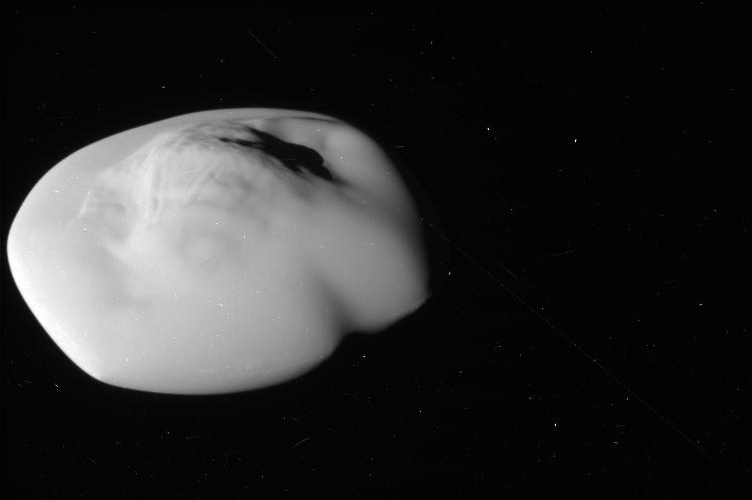
Thanks to the Cassini ISS observations, the orbits and masses of Saturn’s inner satellites (Atlas, Prometheus, Pandora, Janus, Epimetheus) are derived with a high precision (Cooper et al. 2015). Small changes in the semi-major axis of Atlas, the closest object to the main rings, occur on very short timescales. In fact, the orbit of this satellite is chaotic with a Lyapunov time of order 10 years, as a direct consequence of the coupled 54:53 resonant interaction (corotation/Lindblad) with Prometheus (Renner et al. 2016). This makes Atlas another example in the Solar System where chaotic motions can be observed “live”, following the already known case of Prometheus-Pandora (Cooper et al. 2004, Goldreich and Rappaport 2003, Renner et al. 2005).
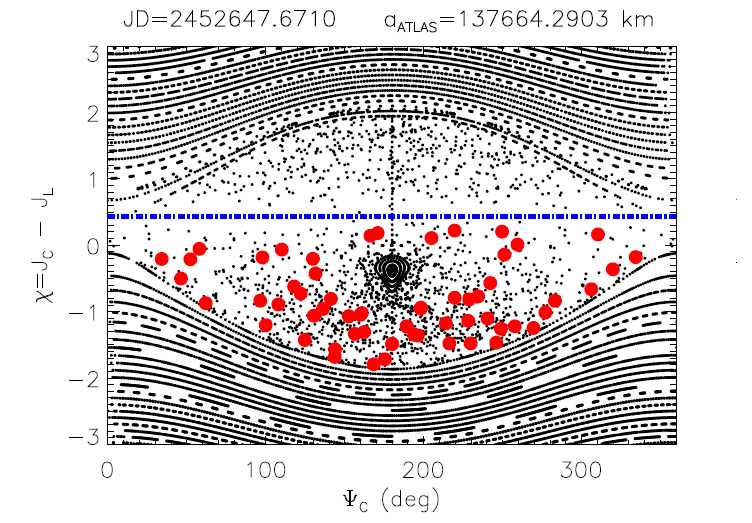
Rings-Satellites Interactions
From stellar occultations to rings physical properties
The Saturnian subsystem, where massive rings and satellites interact, provides us with different means of characterizing rings and satellites. In addition to the direct imaging of the ISS camera on board the Cassini spacecraft, the high resolution (∼ 1 m) of stellar occultations provided by the UVIS (UltraViolet Imaging Spectrograph) instrument allowed us to observe the structures generated by the interactions between satellites and rings. By relying on models of celestial mechanics and on observations of Cassini-UVIS stellar occultations, we were able to model the effects of resonances with these satellites on the rings and in particular the resulting spiral density and bending waves. We have thus been able to identify several of these waves due to resonances with Atlas, Mimas and Pandora, as well as numerous structures that cannot be explained by resonances. These structures made it possible to constrain the physical parameters of the rings: surface mass density, mass extinction coefficient, thickness and mass of the rings, and even particle sizes. In particular, we have shown that with particles being smaller in the ring C, this one could have a different origin from the other rings (Baillié et al., 2011,2013).
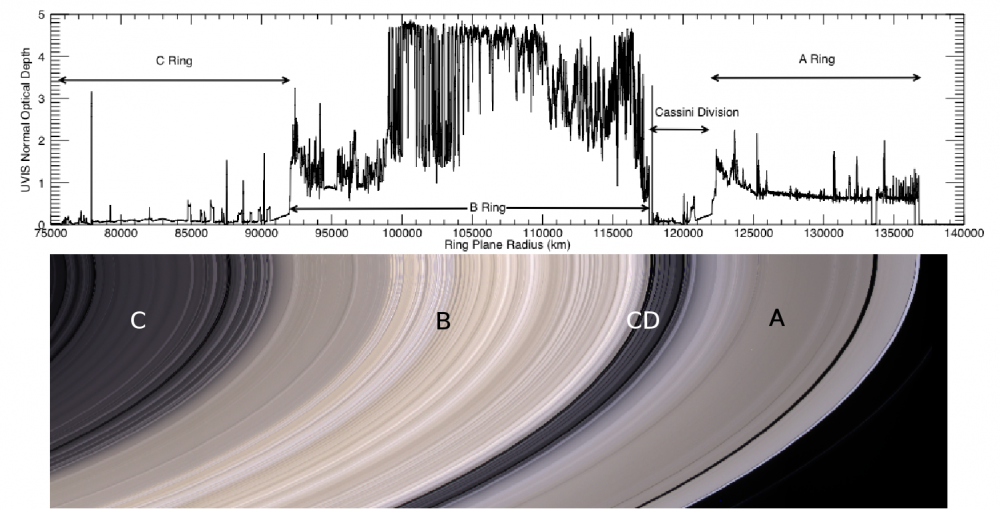 |
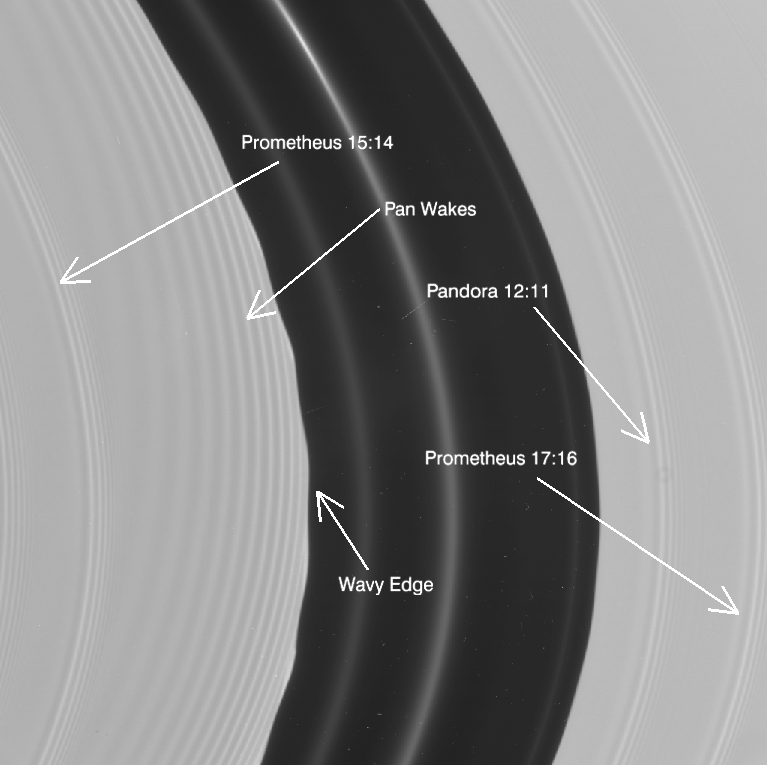 |
|
| The rings of Saturn seen by the instruments of the Cassini probe: ISS at the bottom left (NASA / JPL / SSI, resolution ∼ 10 km) and UVIS stellar occultation profile at the top left. The Encke Division (on the right) is 320 km wide and presents several structures due to satellite-ring interactions: a ringlet trailing Pan (a few images below), density waves, satellite wakes, ring edge shepherding. | ||
Cassini Division Formation
Within the ENCELADE working group, in collaboration with Gabriel Tobie (University of Nantes) and Benoît Noyelles (University of Franche-Comté), we modeled the opening of the Cassini Division by the orbital recession of Mimas. Indeed, the 2:1 resonance with Mimas currently lies at the inner edge of the Cassini Division. Using recent values for the dissipation inside Saturn from Lainey et al. (2017), we were able to simulate the migration and internal heating of Mimas which could be at the origin of Mimas internal ocean suggested by Tajeddine et al. (2014). And by simulating the impact of Mimas on the rings, we showed that the Cassini Division could be opened in just a few million years. The spreading of the rings and the current migration of Mimas allow us to estimate that it could close in about 60 million years and put constraints on the resurfacing of the satellites and therefore the age of the craters. Although Mimas orbital recession has a different origin than planetary migration, the consequences of this "migration" on the redistribution of the ring particles give us clues to understand how planetary migration can affect the dust inside protoplanetary disks, involving a probable difference in treatment for gas.
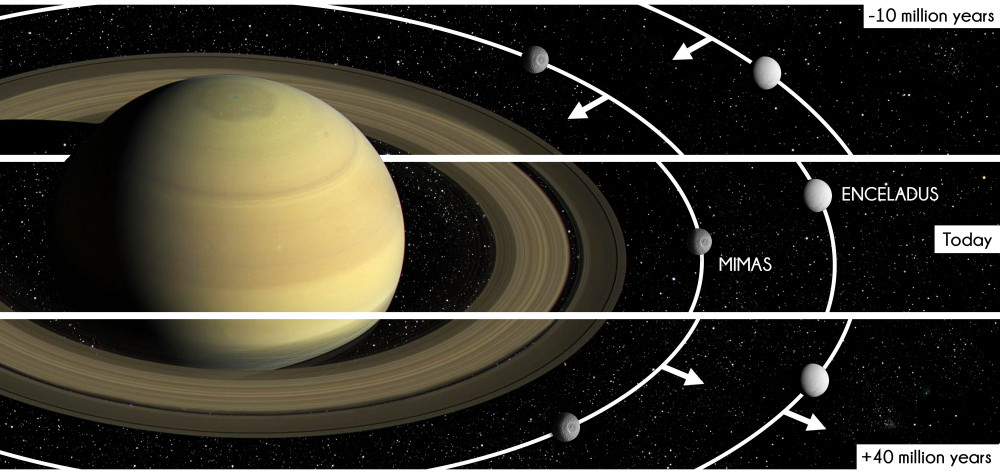
References
- Baillié, K., Noyelles, B., Lainey, V., Charnoz, S., Tobie, G., 2019. Formation of the Cassini Division - I. Shaping the rings by Mimas inward migration, MNRAS 486, 2.
- Baillié, K., Colwell, J.E., Esposito, L.W., Lewis, M.C., 2013. Meter-sized Moonlet Population in Saturn's C Ring and Cassini Division, Astronomical Journal 145, 6.
- Baillié, K., Colwell, J.E., Lissauer, J.J., Esposito, L.W., Sremčević, M., 2011. Waves in Cassini UVIS stellar occultations. 2. The C ring, Icarus 216, 1.
- Cooper, N. J.; Murray, C. D., Dynamical Influences on the Orbits of Prometheus and Pandora, AJ 2004, 127, 1204.
- Cooper, N. J.; Renner, S.; Murray, C. D.; Evans, M. W., Saturnʼs Inner Satellites: Orbits, Masses, and the Chaotic Motion of Atlas from New Cassini Imaging Observations, AJ 2015, 149, 27.
- de Pater, I.; Gibbard, S.G.; Chiang, E.; Hammel, H.B.; Macintosh, B.; Marchis, F.; Martin, S.C.; Roe, H.G.; Showalter, M., The dynamic neptunian ring arcs: evidence for a gradual disappearance of Liberté and resonant jump of courage, Icarus 2005, 174, 263.
- Dumas, C.; Terrile, R.J.; Smith, B.A.; Schneider, G.; Becklin, E. E., Stability of Neptune’s ring arcs in question, Nature 1999, 400, 733.
- Goldreich, P.; Tremaine, S.; Borderies, N., Towards a theory for Neptune’s arc rings, AJ 1986, 92, 490.
- Goldreich, P.; Rappaport, N., Chaotic motions of Prometheus and Pandora, Icarus 2003, 162, 391.
- Goldreich, P.; Rappaport, N., Origin of chaos in the Prometheus-Pandora system, Icarus 2003, 166, 320.
- Hubbard, W.B.; Brahic, A.; Sicardy, B.; Elicer, L.-R.; Roques, F.; Vilas, F. Occultation detection of a Neptunian ring-like arc, Nature 1986, 319, 636.
- Lainey, V., Jacobson, R. A., Tajeddine, R., Cooper, N. J., Murray, C., Robert, V., Tobie, G., Guillot, T., Mathis, S., Remus, F., Desmars, J., Arlot, J.-E., De Cuyper, J.-P., Dehant, V., Pascu, D., Thuillot, W., Le Poncin-Lafitte, C., and Zahn, J.-P., 2017. New constraints on Saturn’s interior from Cassini astrometric data. Icarus, 281, 286–296.
- Namouni, F.; Porco, C.C., The confinement of Neptune’s ring arcs by the moon Galatea, Nature 2002, 417, 45.
- Noyelles, B., Baillié, K., Charnoz, S., Lainey, V., Tobie, G., 2019. Formation of the Cassini Division - II. Possible histories of Mimas and Enceladus, MNRAS 486, 2.
- Porco, C.C., An explanation for Neptune’s ring arcs, Science 1991, 253, 995.
- Renner, S.; Sicardy, B., Stationary Configurations for Co-orbital Satellites with Small Arbitrary Masses, Celestial Mechanics 2004, 88, 397.
- Renner, S.; Sicardy, B.; French, R.G., Prometheus and Pandora: masses and orbital positions during the Cassini tour, Icarus 2005, 174, 230.
- Renner, S.; Sicardy, B.; Souami, D.; Carry, B.; Dumas, C., Neptune’s ring arcs: VLT/NACO near-infrared observations and a model to explain their stability, A&A 2014, 563, A133.
- Renner, S.; Cooper, N. J.; El Moutamid, M.; Sicardy, B.; Vienne, A.; Murray, C. D.; Saillenfest, M., Origin of the Chaotic Motion of the Saturnian Satellite Atlas, AJ 2016, 151, 122.
- Showalter, M.R.; de Pater, I.; French, R.S.; Lissauer, J.J., The Neptune System Revisited: New Results on Moons and Rings from the Hubble Space Telescope, American Astronomical Society, DPS meeting #45, id.206.01.
- Showalter, M.R.; de Pater, I.; Lissauer, J.J.; French, R.S., Ongoing Dynamics and Evolution of Neptune’s Ring-Moon System, American Astronomical Society, DDA meeting #48, id.302.03.
- Showalter, M.; Lissauer, J.J.; de Pater, I.; French, R.S., A Three-Body Resonance Confines the Ring-Arcs of Neptune, American Astronomical Society, DPS meeting #49, id.104.01
- Sicardy, B.; Roddier, F.; Roddier, C.; Perozzi, E.; Graves, J. E.; Guyon, O.; Northcott, M. J., Images of Neptune’s ring arcs obtained by a ground-based telescope, Nature 1999, 400, 731.
- Tajeddine, R., Rambaux, N., Lainey, V., Charnoz, S., Richard, A., Rivoldini, A., and Noyelles, B., 2014. Constraints on Mimas’ interior from Cassini ISS libration measurements. Science, 346, 322–324.
Last update Tuesday 02 February 2021